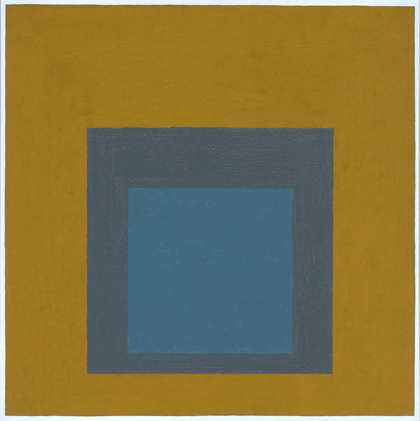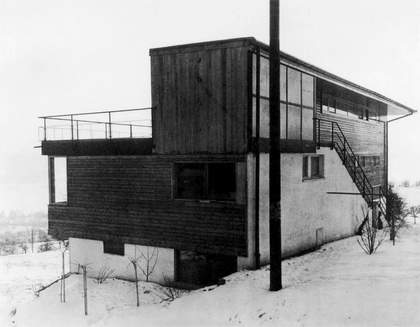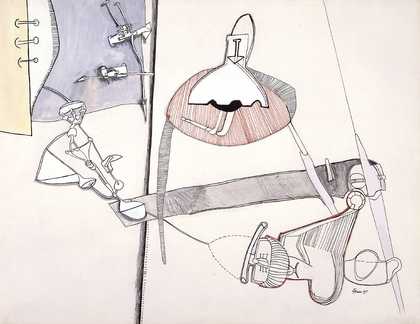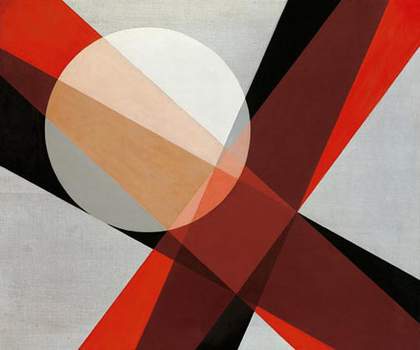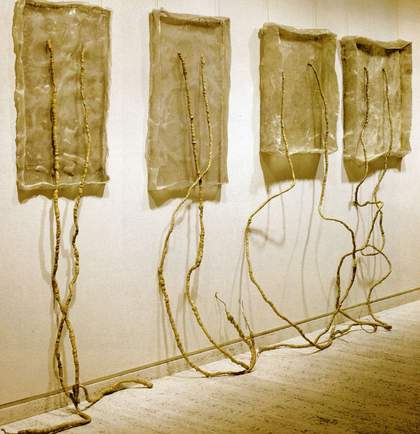
Fig.1
Eva Hesse
No Title 1970
Des Moines Art Center, purchased with funds from the Coffin Fine Arts Trust, Nathan Emery Coffin Collection 1988 © The Estate of Eva Hesse
When one reflects upon the pedagogic practice of Josef Albers it is his colour instruction that likely first comes to mind. The former Bauhaus master’s 1963 publication Interaction of Color and its subsequent paperback editions have long been standard texts and the significance of his perception-based model of ‘color action’ in which visual relationships are developed rather than taken as given cannot be understated in terms of its importance both to art making and art instruction. Yet several of Albers’s students are known for their innovative use of material (like fibreglass and polyester resin in the case of Eva Hesse) despite having been brilliant colourists in their own right.1 This seeming anomaly can be addressed, in part, by looking more deeply at the principles that underscored Albers’s teaching. For Albers, colour was in constant flux. In his instruction he emphasised its relativity as material and its role in creating visual relationships, especially those causing optical estrangement. But in doing so Albers taught his students more than the interaction of colour; he instilled in them a general approach to all material and means of engaging it in design. In his teaching Albers put practice before theory and prioritised experience; ‘what counts,’ he claimed ‘is not so-called knowledge of so-called facts, but vision – seeing.’2 His focus was process.
The Bauhaus-indebted pedagogic tenets that underlay Albers’s teaching were flexible enough so that Eva Hesse (among other of his students) could draw upon his approach to material and design in the making of vastly different work. Indeed, aside from pieces (fig.1) in which Hesse utilised a rectilinear format strikingly similar to Albers’s own iconic use of squares (fig.2), there are few immediate visual similarities between student and teacher. Hesse’s polymorphous, tactile forms that seem to confront viewers with their materiality and the process of their crafting bear little in common with Albers’s rigid compositions. Rather, affinities between the two are expressed in terms of the process-oriented, material-based mode of instruction that constituted a major aspect of the Bauhaus Preliminary Course, dominated Albers’s teaching in the United States, and was key to Hesse’s experimentation with unconventional material. How incongruous that teaching methods often tethered (albeit superficially and in some instances erroneously) to the harsh, machined aesthetic of so-called Bauhaus Modernism might have contributed to making objects so different in appearance. The significance of Albers’s teaching to this end has been largely underestimated. After discussing the genealogy of his pedagogic methods at the Bauhaus, I will show how they are materially evident in Hesse’s mature work.
At the Bauhaus and Beyond
The Bauhaus staff included some of the most influential artists, designers, architects, and educators in the twentieth century. In addition to Albers, also teaching at (or otherwise associated with) the design school were its founding director Walter Gropius, Wassily Kandinsky, Paul Klee, Oskar Schlemmer, Lyonel Feininger, and Ludwig Mies van der Rohe, among several others. Needless to say, pedagogic practice at the Bauhaus was not singular; it was a diverse teaching environment with a shared (albeit evolving) mission to train students in the principles of the applied and fine arts as well as design simultaneously.3 The Preliminary Course had three incarnations roughly corresponding to the tenure of its instructors: Johannes Itten, László Moholy-Nagy, and Josef Albers. Although its character changed significantly under each master, the course served as a creative laboratory where students were to experiment with the foundational elements of design before actually applying these methods and practices to the making of a finished product. Despite curricular, institutional, and political instability, some form of preliminary instruction remained requisite (with rare exception) during each of the design school’s manifestations in Weimar, Dessau, and Berlin between 1919 and 1933. It was the core of the Bauhaus curriculum and served as a unifying experience for students and a common ground from which all began their studies; only after completing the course would they select a specialisation in specific fields such as metal, woodworking, textiles, or ceramics upon joining one of the Bauhaus workshops. Indeed, experimentation with material with this end in view was among the primary aims of preliminary instruction; at the end of each term the faculty would meet to discuss whether students should be allowed to continue their studies and if so, to which workshop they would be admitted based, in part, on their aptitudes for any given material.4
Johannes Itten joined the Bauhaus faculty soon after the design school’s founding and was largely responsible for establishing the tenor of the Preliminary Course at a moment when the school lacked distinct institutional and pedagogic identity. Itten had been trained in primary education and was employed as a schoolteacher before beginning formal art study with Adolf Hölzel at the Academy in Stuttgart. His instruction was informed by theories of early childhood development and, as was key to education reform and Romantic conceptions of individuality, he believed that all people were inherently creative, that the teacher’s role was to unlock students’ creative potential, and saw his task as ‘prepar[ing] and coordinat[ing] physical, sensual, spiritual and intellectual forces and abilities.’5 To this end, he used several unorthodox techniques including rhythmic and improvisatory drawing as well as gymnastics among other body-based, meditative exercises meant to encourage students’ engagement with their sensual and physical selves. In keeping with the tone of Bauhaus instruction at the time, the training of man’s entire creative faculties (of mind, sprit, and body) was key to the instructional programme.
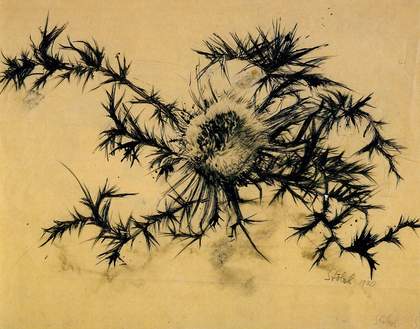
Fig.3
Gunta Stölzl
Thistle
Bauhaus Archiv, Berlin © DACS 2007
Experimentation with material was among Itten’s primary aims for the course. He had his students complete texture and composition studies involving both first-hand interaction with material and the subsequent translation of its material properties into pictorial form using a variety of methods. For instance, Gunta Stölzl created Thistle (fig.3) in ink whereas Margit Téry-Adler rendered the rough-edged, bristly plant using torn paper (fig.4). Other students created elaborate charts to demonstrate the range of texture found in nature. Although Itten stressed direct interaction with the physical world and was himself quite spiritual, he did not claim spiritual value in nature study per se, as did other Bauhaus masters. Rather, he saw the study of nature as ‘above all else a study of the purely material’ through which his students ‘discovered the inexhaustible wealth of textures and their combinations.’6 By representing the properties of a material in drawing or relief sculpture students did more than develop technical skill through mimesis according to the Beaux-Arts tradition of instruction. They actively engaged their senses through which, in Itten’s view, perception was filtered. Additionally, the artist claimed that through exercises dealing with materials and materiality ‘a … new world was discovered: lumbered wood shavings, steel wool, wires, strings, polished wood, … feathers, glass, and tin foil, grids and weaves of all kind, leather, furs, and shiny cans.’7 Itten’s was a method mediated by the body; his exercises involved looking closely and intently so as to discover the world anew through sharpened and refined senses.
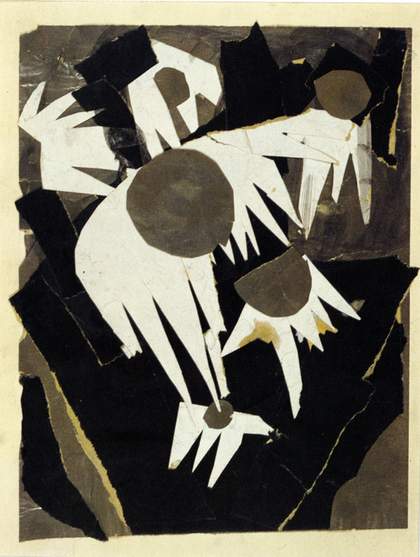
Fig.4
Margit Téry-Adler
Composition study, Carline Thistle, c.1920
Kunstsammlungen zu Weimar © The Estate of Margit Téry-Adler
In marked contrast to Itten, László Moholy-Nagy was largely self-taught. Not having experienced the rigour of institutionalised art training and perhaps less familiar with contemporary discourse on pedagogy, he is known most for enlivening the Bauhaus through his interest in new technology and new media. He taught the Preliminary Course from 1923 to 1928. Believing that ‘to be a user of machines [was] to be of the spirit of this century,’ Moholy-Nagy’s view of art was one tethered to the social realities of an industrial society (and Constructivism) rather than artistic tradition per se.8 And although his interest in technology might imply that his method of art instruction would be sterile, formulaic, and detached, it was in fact quite the opposite. Among his stated instructional aims was to elicit ‘spontaneity and inventiveness’ and hence, to awaken his students’ creative capabilities. Like Itten, he had students perform ‘tactile experiments’ believing that through physical engagement with the tactile, the optical would be developed. There were, however, differences between the two. Whereas for Itten engagement with the senses also involved the aestheticisation of natural material, for Moholy-Nagy it was about their actual properties and effects. He had students organise natural and industrial matter by ‘surface effect’ in elaborate tactile charts. They did so according to set categories, the most important being ‘surface aspect,’ which related to how one would use material to achieve a desired sensory result, presumably from a product one might design. It was not only important to train one’s ability to transfer nature into design, but also to distinguish variation in nature and its respective sensory qualities. Students explored both the aesthetic and the communicative properties of materials under Moholy-Nagy’s tutelage, through which they developed a design sensibility. As he said, ‘not the product, but the man is the end in view.’ In terms of design, Moholy-Nagy’s teaching was directed toward simplicity and ‘elemental expression’ by reducing variety in nature to basic properties used to create products that had agency.
Josef Albers was Itten’s student at the Bauhaus, taught the Preliminary Course in tandem with Moholy-Nagy beginning in 1923, and assumed sole responsibility for the course from 1928 until the design school closed in 1933.9 Like Itten, he had been trained as educator and in the Academy system (under Franz von Stuck in Munich) prior to beginning his tenure at the Bauhaus, where he was one of few individuals affiliated with the design school during each of its manifestations. In keeping with the increased importance of industry at the Bauhaus, Albers’s instruction was geared toward general design principles, which he saw as a means of visual organisation. He would later describe his approach as that of creating ‘visual empathy’ through which one gained ‘the ability to read the meaning of form and order.’10 Like Itten and Moholy-Nagy before him, he sought to engage his students’ imaginations by acclimating them to their physical environment and encouraged students to seek answers from material itself.
Albers believed that one learned as a result of a direct interaction with life and required that his students become familiar with the physical nature of the material world. This was due, in part, to the influence of John Dewey, who advocated for laboratory-based education and coined the phase ‘learning by doing.’ For Dewey, ‘the conditions of daily life’ determined the ‘nature of experience’ and thus, art (aesthetic experience) was to be actively engaged.11 Indeed, he often praised Dewey, whose ideas were fundamental to the founding of Black Mountain College, where Albers first taught in America from 1933 to 1949. And like Dewey, his pedagogic emphasis lay in practical, concrete exercises: in the artist-educator’s own words ‘learning through conscious practice.’ Similar notions, including the Montessori method as well as those of Froebel, Pestalozzi, and others key to discourse on early childhood development were fundamental to the educational programme of the Bauhaus. Considering that both Itten and Albers had been trained as schoolteachers and the degree to which education served as a means for social change at the Bauhaus, devising methods of instruction akin to how it was believed one learned was essential to preliminary instruction.
Learning how the parts constitute the whole through active engagement with material underscored all of Albers’s teaching. In his preliminary instruction he emphasised that the student must experiment with material in order to truly understand its potential use and limitations in design and, like Itten, he encouraged his students to work with a wide variety of material including cardboard, wire, glass, straw, rubber, matchboxes, and razor blades and would often charge them to explore the properties of a singular material, specifying which tools, if any, could be used to this end. As such, the student would discover a material’s inherent design qualities by using it to create a new structure. This approach is best exemplified by exercises in which students were to explore the properties of paper (fig.5), and only allowed to cut or fold it so as to create forms that highlighted its structural potential. About these exercises Hannes Beckmann recalled:
I remember vividly the first day of the [Preliminary Course]. Josef Albers entered the room, carrying with him a bunch of newspapers. … [and] then addressed us … ‘Ladies and gentlemen, we are poor, not rich. We can’t afford to waste materials or time. … All art starts with a material, and therefore we have first to investigate what our material can do. So, at the beginning we will experiment without aiming at making a product. At the moment we prefer cleverness to beauty. … Our studies should lead to constructive thinking. … I want you now to take the newspapers … and try to make something out of them that is more than you have now. I want you to respect the material and use it in a way that makes sense – preserve its inherent characteristics. If you can do without tools like knives and scissors, and without glue, [all] the better.’12
In both his material and later his colour studies, Albers’s concern was that of finding solutions to problems – his pragmatism was very much that of an artist who thought in terms of design.
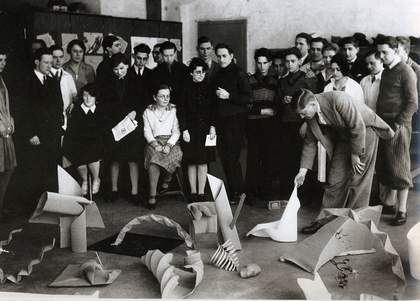
Fig.5
Assessment of work from Albers’s Preliminary Course, 1928–9
Photo by Umbo (Otto Umbehr) © The Joseph and Anni Albers Foundation / VG Bild-Kunst, Bonn and DACS, London 2007
At its core, preliminary instruction was meant to be widely applicable. All Bauhaus students, be they joiner, bookbinder, potter, weaver or stage designer received the same instruction, which stressed experimentation with material so as to understand its potential use. But more, they didn’t make products out of paper at the Bauhaus; paper wasn’t the point. It didn’t really matter if you crafted your thistle in pen and ink or as collage. These were exercises, merely examples of an approach. They were a means to flexible thinking that would attune students to the material of their environments and result in an innovative use of material in design. As Howard Singerman has mentioned, this key distinction has been largely confused in America, where aspects of a curriculum intended to train designers were taken up at art schools and by students who saw themselves as artists.13 Bauhaus pedagogic practice should be seen as it was: a training method in design. Instead, it has been too often subsumed by notions of so-called Modernist art teaching, of which Albers has long been emblematic and against which artists and critics have railed. It has been common to conclude that instructional methods originating at the Bauhaus were ‘based on the reduction of practice to the fundamental elements of a syntax immanent to the medium’ and if its methods function today, they do so ‘in spite of themselves.’14 The conflation of Bauhaus methods with the medium-centric concerns of art criticism, however, has obscured the range of their significance as approach, process, or way of thinking in the twentieth century and, importantly, how these actual instructional methods may have been influential to artists like Hesse trained in a Bauhaus-indebted tradition.
Although Albers developed his colour course subsequent to his emigration to the United States, it reflected a Bauhaus-indebted approach to material instruction nevertheless, as did his instruction generally.15 Students used foliage (fig.6) and Color-aid paper in their studies, employing materials available to them to study the material of colour itself; they did not mix pigments to create a new, composite colour. In his colour course the former Bauhaus master created a structured environment in which he encouraged students to experiment with colour by assigning exercises (problems to be solved) meant to attune students to perceptual phenomena and by extension, the interaction of colour. One came to appreciate the relativity of colour upon completing Albers’s course; but more, the means to the end were in themselves significant. Students met Albers’s charge to use colour relationships to create the illusion of volume, numerous surface effects, or the appearance of transparency (fig.7) through a process of trial and error, often by placing countless pieces of paper in juxtaposition with one another until arriving at the desired effect. Above all else, his colour instruction was meant to challenge students to discover the potential (and limitations) of colour-as-material and its use in the design. And like all his instruction it was not geared toward a prescribed end; students ultimately were to make use of his methods on their own terms.

Fig.6
Eva Hesse
Free Study with leaves
Plate XXV–I, Interaction of Color, 1963
© Yale University Press
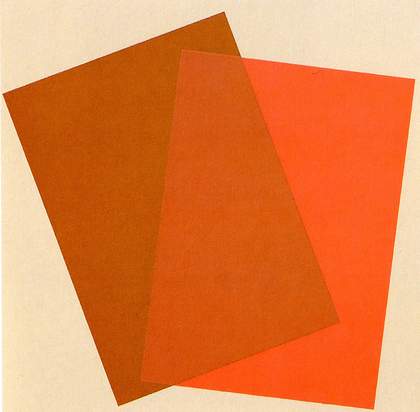
Fig.7
James McNair
Color mixture and illusion of transparence
Plate IX-I, Interaction of Color 1963
© Yale University Press
After Albers
Eva Hesse had little praise for her Yale education and Albers seemed aware of this. Upon her death he sent a photograph of himself with Hesse (fig.8) to the Fischbach Gallery asking if her heirs might want to have a picture ‘showing her with me as her painting teacher … despite [my emphasis] my being in it.’16 Although she was among Albers’s favourite pupils, Hesse disliked him in so much as his views were not in keeping with her then expressionist painting technique and by extension, for what she perceived as the restrictiveness of his approach. Upon hearing a lecture by her teacher she wrote in her diary: ‘He is terribly limited but really maintains one point of view throughout. This is a paradoxically strong and weak attribute and shortcoming.’17 Many scholars and critics have addressed Hesse’s stated frustration with Yale University and Albers as part of diverse arguments about the artist, her work, and Modernism.18 Yet Linda Norden is one of few who has discussed Hesse’s formal education in depth and to my knowledge no one has written extensively about how (in a pedagogic sense) she was trained.19 Hesse’s work is intriguing because she studied with Albers, who along with Moholy-Nagy was largely responsible for the dissemination of Bauhaus-indebted teaching ideas in the United States – ideas to which Hesse likely had been exposed prior to her studies with the former Bauhaus master directly.
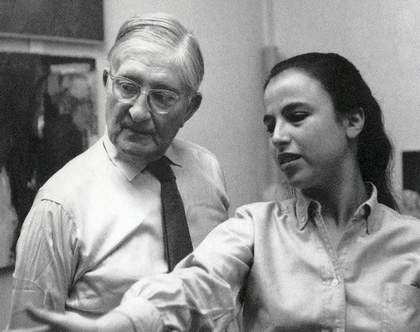
Fig.8
Josef Albers and Eva Hesse, Yale University, c.1958
© The Estate of Eva Hesse. Hauser & Wirth Zürich London and The Joseph and Anni Albers Foundation / VG Bild-Kunst, Bonn and DACS, London 2007
In 1952 Hesse graduated from the School of Industrial Arts (today the High School of Art and Design) in New York, a school intended to train commercial artists and at which she studied window display.20 In 1952 and 1953 she attended courses in advertising design at the Pratt Institute, at which Albers had been visiting professor in 1949, prior to assuming his duties at Yale. In addition to painting, Hesse studied ‘two-dimensional and three-dimensional design’ at Pratt but did not complete this course of study.21 From 1954 to 1957 she studied design at the Cooper Union,22 where former Bauhaus student Hannes Beckmann (quoted above) taught along with Neil Welliver, another Albers’s student and later a member of the Yale faculty who taught an ‘Albers-oriented color course that really jarred all of us’ according to Hesse’s classmate Camille Reubin Norman.23 And then there was Yale and Albers, with whom Hesse studied colour and ‘advanced’ painting.24 Finally, upon graduating from Yale she worked briefly for Boris Kroll as a textile designer and thus, in an applied art central to the Bauhaus curriculum and dominated by its legacy, especially the work, teaching, and writings of former Bauhaus student and Josef’s wife, Anni Albers.25 Indeed, a common thread uniting each of Hesse’s educational experiences is that of instruction in design and by extension, the Bauhaus and Albers.26 In light of the process-oriented, material-based approach to design instruction propagated at the Bauhaus and its subsequent importance (largely because of Albers) in America, it would be legitimate to propose that Bauhaus-indebted pedagogic methods and practices may have been a formative influence upon Hesse (in an epistemological sense) in terms of her approach to matter generally and especially her experimentation with its design properties.
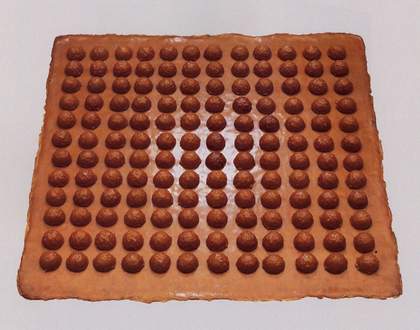
Fig.9
Eva Hesse
Schema 1967–8
Philadelphia Museum of Art, gift of Helen Hesse Charash 1979 © The Estate of Eva Hesse
Hesse defined the word ‘schema’ as ‘synopsis, outline, diagram. general type, essential form, conception of what is common to all members of a class.’27 While the evenly-spaced, balanced grid of her eponymous sculpture (fig.9) may be read in terms of Hesse’s definition, her interest in ‘diagram’ and ‘essential form’ are also expressed in the meticulous planning and rigor with which she approached its design, including her choice of material. In addition to drawings,28 Hesse made numerous ‘test pieces’ (fig.10) prior to the execution (by her own hand or otherwise) of many of her works. She used these ‘material studies’ to experiment with the structural properties of rubber, papier-mâché, Sculp-Metal, and other matter so as to determine, in part, their potential usefulness in crafting specific forms like hemispheres, cylinders, and various vessels. For Schema, she chose to work in latex, as she did many of her sculptures dating from the late 1960s and about which she stated: ‘the materials I use are really casting materials, but I don’t want to use them as casting materials. I want to use them directly, eliminating making molds and casts … I am interested in the process, a very direct kind of connection.’29 Indeed, the building up of latex surfaces in layers intrigued Hesse, but her experimentation with material prior to determining that latex suited her purposes was an extension of Albers’s exercises. As had been the case at the Bauhaus, Albers’s students were to seek answers from material itself; his hands-on exercises informed the process through which Hesse arrived at her final forms as well as her inquisitiveness regarding the potential of unconventional artistic matter.
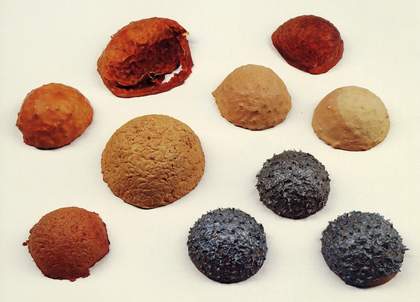
Fig.10
Eva Hesse
(test pieces) 1967
University of California, Berkeley Art Museum & Pacific Film Archive, gift of Helen Hesse Charash 1979 © The Estate of Eva Hesse
That meaning lies in how Hesse engaged material has been part of the artist’s critical reception from the onset of her work in sculpture. Rosalind Krauss, for instance, has characterised Hesse as working counter to the ‘formalist dialogue of the 1960s with the message of expressionism … ‘manifested through the experience of matter itself.’30 In 1968 Robert Morris included the artist in his Anti Form exhibition at the Castelli warehouse know as ‘Nine at Leo Castelli.’ Morris showcased work generated through a ‘direct investigation of the properties of … materials’ for which there was no predetermined form and thus, ‘random piling, loose stacking, [or] hanging [gave] passing form to material.’31 Hesse contributed Augment and Aught, the former (fig.11) consisting of nineteen sheets of latex-infused canvas layered upon one another and installed on the warehouse floor. Also represented in the show was fellow-Albers-student and Hesse’s friend, Richard Serra, who created his legendary piece Splashing (fig.12) for the exhibition by throwing molten lead against a wall, allowing the work to assume its own form.32 According to Robert Pincus-Witten, in the late 1960s Serra was teaching at Queens College. About his teaching method, Pincus-Witten recalled what to my ear is at its core quite reminiscent of Albers and Bauhaus pedagogic practice. He stated:
Serra’s teaching … deals with an elementarist analysis of the physical properties germane to any given material. It minimizes–almost to extinction–any valorized finished product, but instead stresses those issues and procedures which are central to the execution of any specific act, or set of acts, in as clear and [as] didactic a way … possible.33
He continues, claiming, ‘the implications of this [approach] in terms of many of the features of Serra’s own work are self-evident.’34
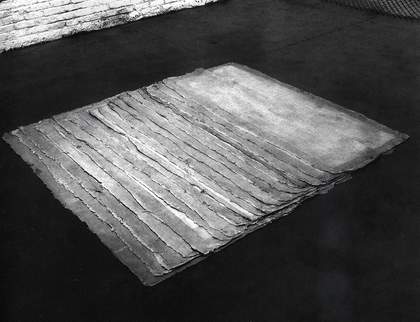
Fig.11
Eva Hesse
Augment 1968
Kaiser Wilhelm Museum, Krefeld, Sammlung Helga und Walter Lauffs 1970 © The Estate of Eva Hesse
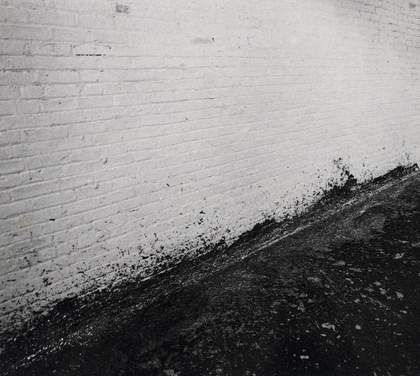
Fig.12
Richard Serra
Splashing, 1968
Installed Castelli Warehouse, New York 1968 (destroyed)
© ARS, NY and DACS, London 2007
Throwing lead, polymorphous Fiberglass forms, and painted latex: nothing to do with color, nothing indeed. But unlike Sol LeWitt’s quip that ‘Hesse’s avoidance of color probably [had] everything to do with [her] being a student of Albers,’35 one must bear in mind that Albers taught his students far more than colour, even when teaching colour. He instilled in his students a general approach to artistic material by encouraging directed experimentation with the properties of any given material. How they, as artists, chose to make use of his instruction is altogether another (and individual) matter. In fact, Albers likely would not have approved of work involving (in the case of Splashing) an arbitrary element; it was antithetical to his approach to design as that embracing ‘all means opposing disorder and accident.’36 But whether Albers approved of Hesse, Serra, or any of his students’ work (and vice versa) is beside the point. The two are united as students of Albers and by extension, the process through which each came to understand and engage their respective creative materials.37
Forging relationships between teacher and student is nothing new to art history. Giorgio Vasari speaks not of Michelangelo without acknowledging Ghirlandaio as his teacher in Le Vite (1550) and Ingres’s petulant fancy is seen in more charming relief in light of his studies with the academician David. Indeed, it has been preferable that pupil defy master, thus fueling the symbolic wheels of progress and change that propel many art historical narratives. While a lack of equal access to instruction has been noted as one of several factors that historically excluded women from professional art practice, studies of pedagogical methods within these exclusive institutions have been slow in coming, especially those that move beyond stylistic classification and direct comparison between student and teacher. Pedagogies act as does ideology: surreptitiously and often without notice. They help structure how we think, let alone how we learn whether we realise it or not. As is clear when one views Eva Hesse’s work in light of Albers’s teaching methods, pedagogy can affect art practice in myriad ways. Perhaps there is no better reason than this for artists to view teaching as an imperative.
Subsequent to my first presentation of this paper several major texts on Eva Hesse and Josef Albers have been published including: Briony Fer, ‘Eva Hesse and Color’, October 119, Winter 2007, pp.21-36, Catherine de Zegher ed., Eva Hesse Drawing, New Haven and London, 2006; Elisabeth Sussman and Fred Wasserman, Eva Hesse Sculpture, New Haven and London, 2006; Renate Petzinger and Barry Rosen ed., Eva Hesse Catalogue Raisonné, New Haven and London, 2006; Griselda Pollock and Vanessa Corby ed., Encountering Eva Hesse, Munich, 2006; and importantly, a monumental text devoted to Albers’s teaching, Frederick A. Horowitz and Brenda Danilowitz, Josef Albers: To Open Eyes, London, 2006 as well as the catalogue from Tate Modern’s eponymous exhibition, Achim Borchardt-Hume ed., Albers and Moholy-Nagy: From the Bauhaus to the New World, London, 2006. I have incorporated the views of many, but not all of these authors above and in my notes.

